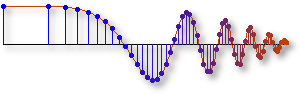FM Synthesis of Instrument Sounds
In class you learned that with signals of the form
\(x(t)=A \cos(\psi(t))\),
the instantaneous frequency of the signal is the derivative of the
phase \(\psi(t)\).
So, if \(\psi(t)\) is constant, the frequency
is zero.
If \(\psi(t)\) is linear, \(x(t)\) is a sinusoid at some fixed
frequency.
If \(\psi(t)\) is quadratic, \(x(t)\) is a chirp signal whose
frequency changes linearly versus time.
FM synthesis uses a more interesting \(\psi(t)\), one that is sinusoidal.
FM, meaning “frequency modulation,” refers to the fact that the
frequency of \(x(t)\) changes according to the oscillations of
\(\psi(t)\).
This is useful for synthesizing instrument sounds because the
proper choice of the modulating frequencies will produce a
fundamental frequency and several overtones, as many instruments do.
The general equation for an FM sound synthesizer is:
$$x(t)=A(t) \cos[\omega_ct + I(t) \cos(\omega_mt + \phi_m) + \phi_c] \qquad(1)$$
In \((1)\), \(A(t)\) is the signal's amplitude.
It is a function of time so that the instrument sound can be made
to fade out slowly or cut off quickly.
Such a function is called an envelope. The frequency
\(\omega_c\) is called the “carrier” frequency.
Note that when you take the derivative of
\(\psi(t)\) to find \(\omega_i(t)\), \(\omega_c\)
will be a constant in that expression.
It is the frequency that would be produced without any frequency
modulation.
The parameter \(\omega_m\) is called the "modulating" frequency.
It expresses the rate of oscillation of \(\omega_i(t)\).
The parameters \(\phi_m\) and \(\phi_c\) are arbitrary phase constants,
usually both set to \(-\frac{\pi}2\) so that \(x(0)=0\).
The function \(I(t)\) has a less obvious purpose than the other
parameters of FM signals.
It is technically called the “modulation index envelope.”
To see what it does, examine the expression for the
instantaneous frequency:
$$\begin{align}
\omega_i(t) & = \frac{d}{dt} \psi(t) \\
& = \frac{d}{dt} [ \omega_ct + I(t) \cos(\omega_mt + \phi_m) + \phi_c] \\
& = \omega_c - I(t) \omega_m \sin(\omega_mt + \phi_m) + \frac{dI}{dt} \cos(\omega_mt + \phi_m)
\end{align}$$
If \(I(t)\) is constant, then \(I(t)\omega_m\) gives the maximum
amount by which the instantaneous frequency deviates from
\(\omega_c\).
Beyond that, however, it is difficult to relate \(I(t)\) to the
sound made by \(x(t)\) without some rather complicated analysis.
Nonetheless, we would like to characterize
\(x(t)\) as the sum of several sinusoids
instead of a single signal whose frequency changes.
In this regard, the following comments are relevant:
when \(I(t)\) is small \(I \approx 1\)), low multiples of the carrier
frequency \((\omega_c)\) have high amplitudes.
When \(I(t)\) is large \((I>4)\), both low and high multiples
of the carrier frequency have high amplitudes.
The net result is that \(I(t)\) can be
used to vary the overtone content of the instrument sound (overtones are
harmonics).
When \(I(t)\) is small, mainly low frequencies will be produced.
When \(I(t)\) is large, higher harmonic frequencies can also be produced.
For more details see the paper by Chowning [1].
Below are some examples of sounds that can be synthesized with the
appropriate choice of \(A(t)\), \(I(t)\), \(\omega_c\),
and \(\omega_m\). These sounds were originally synthesized by Robbie Griffin.
Jeff Schodorf, Feb-20, 1996
| Instrument | Carrier Frequency (Hz) | Modulating Frequency (Hz) | Audio |
|---|---|---|---|
| Brass | 900 | 300 | |
| Clarinet | 900 | 600 | |
| Bell | 110 | 210 | |
| Knocking Sound | 80 | 55 |
[1] John M. Chowning, “The Synthesis of Complex Audio Spectra by means of Frequency Modulation,” Journal of the Audio Engineering Society, vol. 21, no. 7, Sept. 1973, pp. 526–534.
Jeff Schodorf, Feb-20, 1996
